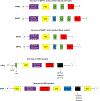Mitochondrial fusion and fission: The fine-tune balance for cellular homeostasis
- PMID: 34048084
- PMCID: PMC8415099
- DOI: 10.1096/fj.202100067R
Mitochondrial fusion and fission: The fine-tune balance for cellular homeostasis
Abstract
Mitochondria are highly dynamic, maternally inherited cytoplasmic organelles, which fulfill cellular energy demand through the oxidative phosphorylation system. Besides, they play an active role in calcium and damage-associated molecular patterns signaling, amino acid, and lipid metabolism, and apoptosis. Thus, the maintenance of mitochondrial integrity and homeostasis is extremely critical, which is achieved through continual fusion and fission. Mitochondrial fusion allows the transfer of gene products between mitochondria for optimal functioning, especially under metabolic and environmental stress. On the other hand, fission is crucial for mitochondrial division and quality control. The imbalance between these two processes is associated with various ailments such as cancer, neurodegenerative and cardiovascular diseases. This review discusses the molecular mechanisms that control mitochondrial fusion and fission and how the disruption of mitochondrial dynamics manifests into various disease conditions.
Keywords: diseases; dynamics; fission; fusion; mitochondria.
© 2021 Federation of American Societies for Experimental Biology.
Conflict of interest statement
Conflict of Interest: The authors declare no conflicts of interests
Figures




References
Publication types
MeSH terms
Grants and funding
LinkOut - more resources
Full Text Sources
Other Literature Sources

